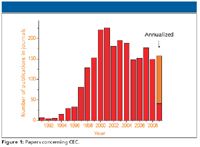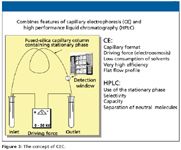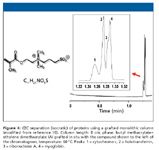What Ever Happened to Capillary Electrochromatography?
LCGC North America
In this installment, columnist Ron Majors and guest columnist Frantisek Svec address the current status of CEC, once the hottest topic in the field.
Over a decade ago, a new separation technique arose that was a variant of high performance liquid chromatography (HPLC) in which an electric field rather than an applied pressure drove the flow of mobile phase. The driving force was electroosmotic flow (EOF) and years before, in 1974, Victor Pretorius and coworkers (1) predicted that if EOF was used as a driving force for mobile phase flow rather than hydrodynamic flow, the efficiency of separations could be enhanced due to the flat band profile longitudinally across a column. The work of Jorgensen and Lukacs (2) in the early 1980s made use of EOF in open tubular capillaries and demonstrated low reduced plate heights. Although more attention was devoted to the development of capillary electrophoresis (CE) through the next decade, by the late 1990s, the principles of capillary electrochromatography (CEC) in packed capillaries had been demonstrated and this method was generating a great deal of attention. Any separation science conference or separation science session at major analytical instrument shows usually had standing room only and often, people were straining to get a view of the presentations in the hallway outside of the lecture room. Clearly, this was an exciting time, for researchers had predicted that CEC would have the selectivity of HPLC due to the presence of the stationary phase and have the efficiency of CE due to its high plate counts. There was even a belief that CEC could replace both HPLC and CE.

Ronald E. Majors
Today, one barely hears of CEC. At this year's HPLC 2009 meeting in Dresden, Germany, out of nearly 770 oral and poster papers, under 2% of the papers (one oral and 12 posters) addressed this topic, mostly around application examples. Crowds no longer strain to get a glimpse of a capillary electrochromatogram. How could this all come about after the extreme interest only ten years ago?

Figure 1
Still today, CEC has a following. Figure 1 shows the number of CEC papers published in the last decade and a half. Although the pace has somewhat slowed down, there has been an average of around 150 papers per year; that means that scientists are still investigating the parameters and developing applications despite the lack of commercial support. If one adds to it the number of patents involving CEC (Figure 2), there is a definite interest in the development of novel technologies around this field. So, again why isn't CEC gaining a foothold?

Figure 2
Earlier this year, at the 33rd International Symposium on Capillary Chromatography (ISCC) in Portland, Oregon, the subject of the apparent demise of CEC was the topic of a lively discussion session led by one of the authors of this text (FS). Some of the reasons why CEC has not come into favor were discussed among the many capillary experts in the audience as well as practitioners, many of whom never took up the technique. The same difficulties experienced with CEC that were brought up years ago were restated, but there was no general consensus on the main reasons for the low interest in CEC today.
In this installment of "Column Watch," using the ISCC discussion session as a starting point, we will explore the present state of the technology, speculating on reasons why the technique has not yet caught on, and present some arguments on why researchers should not give up on further investigations of the challenges that face CEC. We will also rely upon expert opinions that took place in a survey article in 1998 to see if any of their predictions came to pass (3).
Brief Review of CEC Principles
As depicted in Figure 3, to perform CEC, a fused-silica capillary packed with stationary phase is used as a column. The EOF is generated by applying a large voltage (up to 30 kV) across the column that is filled with electrolytes, usually buffer with a concentration of 1–50 mM. Positive ions of the added electrolyte accumulate in the electrical double layer of the column packing particles and move toward the cathode and drag liquid mobile phase with them. The column diameters are very small (~50–100 µm) to minimize thermal gradients from ohmic heating; otherwise the heat generated could have a detrimental effect on analyte bandwidths and even cause boiling of mobile phase, thereby generating vapor bubbles that interrupt EOF. UV detection is performed on-column by removing a small amount of polyamide coating and viewing the mobile phase as it passes through the window in the fused-silica tubing. However, other detection methods have been used including electrochemical, mass spectrometry (MS), and laser-induced fluorescence.

Figure 3
Column-packing materials are held in place by a frit usually constructed of sintered glass beads, sintered silica gel packing, monolithic plugs, magnetic immobilized beads, and other approaches. The sintered frits have been a major source of problems and appear to be an area of frequent bubble formation, band broadening, fragility, poor porosity, and poor reproducibility. Conventional HPLC column materials such as bonded silicas and ion exchangers are the most frequently used stationary phases. However, this is an area of continued development since EOF depends very heavily on the nature of ionizable groups on the surface of these packings and often reproducibility problems can be related to lack of control of these characteristics. Monoliths have been used for CEC columns and do not need fabricated frits to hold them in place.
Advantages of CEC
The most obvious advantage of CEC was already stated: CEC combines features of CE and HPLC. For CE and CEC, both take place in a capillary format and the driving force is voltage. Both techniques use very small amounts of solvent and provide very high efficiency. CE works best for charged molecules although small neutral molecules can be separated using micellar techniques, but not as optimally as HPLC.
CEC also has the advantages of HPLC: It uses the same types of stationary phase, although since the stationary phase assists in generating EOF, stationary phases must be judiciously selected in CEC. Like HPLC, the primary mechanism of separation is the partitioning of analyte between the liquid mobile phase and the solid stationary phase. Due to the HPLC packing in the column, CEC provides excellent selectivity and higher sample capacity compared to CE, which is frequently mass-limited. In contrast to CE, neutral molecules are more easily separated by CEC, just like HPLC. Unlike HPLC, where the pressure through the column is inversely proportional to the particle diameter squared and directly proportional to column length, the flow rate in CEC is independent of particle diameter and column length and there is no pressure dependency. So, CEC has the potential to generate higher plate counts than HPLC. The plug-like flow velocity profile in EOF reduces band dispersion and thus further aids CEC efficiency. Further reductions in particle diameter to the new sub-2-µm packings are quite possible and even particles in the sub-1-µm range (4) would come close to the CEC perfect packing material theoretically predicted by Knox and Grant in 1987 (5).
An interesting observation for the CEC capillary column compared with CE and HPLC is that the column serves as the injector, the pump, the separation device, and the detector cell (for UV). So, it is asking a lot for it to operate under optimal and well-controlled conditions for all of these experimental parameters.
Limitations of and Challenges in CEC
From the beginning, CEC faced some major obstacles. As with any new separation technology, CEC showed the classic shortcomings: poor robustness, column variations, low sample capacity, low volume loadability, problematic injection techniques, and insufficient sensitivity. Initially, most researchers either built their own CEC systems or modified commercial CE units as best they could. To this day, there are still no commercial instruments specifically designed for CEC applications. Thus, those separation scientists who might like to explore the technique and cannot take the time to build and maintain their own instruments and capillaries are not able to purchase commercial equipment. Areas in which improvement in the operational side of CEC is required include injection techniques (other than electrokinetic), addition of gradient elution (pressurized), and detectors more suited and more easily interfaced to the technique. Clearly, a commercial unit with the reliability and reproducibility of an HPLC system would be highly desirable.
From the beginnings of CEC, the packed capillaries were a source of headaches. Most early researchers packed their own capillaries using slurry techniques that were well tested for HPLC columns. To contain the packing in the fused-silica capillary, frits had to be constructed in situ. For those preparing the CEC capillaries themselves, making the frits was always a challenge. They had to show good permeability, be nonsorptive or nonreactive, and be able to stand up to high-pressure slurry packing (mechanical stability). The formation of bubbles in the vicinity of frits has always plagued CEC. Bubbles are thought to be formed by nucleation or outgassing of the mobile phase at the frit that results from the heat generated by high electric fields. An alternative explanation was that the changes in EOF as the mobile phase crosses the outlet frit from the packed to the unpacked portion of the capillary cause these bubbles. It has been shown that poorly constructed frits accentuate bubble formation. Bubbles seem to be worse when gradients are used with organic solvents, lending some credence to the changes in EOF at the frit. Bubble formation cuts the electrical conductivity and stops the mobile phase flow. The column must then be removed or mechanically flushed to rewet it before the CEC experiment can continue. Attempts have been made to immobilize stationary phase particles by various means (6) but required laboratory skills that are outside of the scope of most workers.
Column-to-column reproducibility has also been a limitation. Because EOF is controlled mainly by the surface of the packing material, any slight variations in the packed bed, surface characteristics of the packing, or pH of the mobile phase (especially for silica-based reversed-phase packings in which the EOF is controlled by silanol ionization) will cause a difference in retention time and perhaps selectivity. Column ruggedness also appears to be a shortcoming when compared with that of HPLC columns.
The development of commercial packing materials optimized for CEC never came true. Some workers are still using packings made primarily for HPLC; only in studies in monolith technology have there been materials that have been optimized for CEC (6). The ability to have reproducible EOF lies in the ability to make reproducible, reliable packings suited for CEC.
It often has been stated that for CEC to become an established technique, it would have to find an application "niche" in which HPLC and CE could not meet the needs of the analysis. Certainly, supercritical fluid chromatography (SFC) was found to be more accepted when the separation of enantiomeric compounds, especially on a preparative basis, switched over to this technique. CEC has not found this "killer" application yet.
Expert Predictions (1998) and ISCC Updated Discussions (2009)
During the 1998 survey, experts in the CE/CEC/HPLC field were asked a series of questions about the advantages and shortcomings of CEC at the time. Furthermore, they were asked for predictions about how the shortcomings would be overcome, whether CEC would go more into the separation technology mainstream, and where the technology was going in the next five years (1998–2003). The same types of questions were posed to the audience at ISCC. Within this 10-plus year span, there was a great deal of agreement as to the issues holding back the general acceptance of CEC. In this section, we will explore some of the issues one by one.
Commercial instrumentation will be developed: In the opinion of the majority of the experts (4), for CEC to be successful, manufacturers would have to develop dedicated instrumentation. Some features that would be required would be the capability for both pressure- and EOF-driven flow. Some even suggested a trifunctional instrument capable of performing CE, CEC, and microLC. The late Professor Csaba Horvath even came up with a name — the "Triskelion." Gradient elution capability and the ability to perform hydrodynamic injection of discreet volumes were musts. The ability to flush the capillary columns was a strong desire as, at the time, bubble formation was a limiting factor in reliability of modified CE and homemade instruments. The requirement to use gradient elution to handle wide varieties of analyte types was a must.
To make a long story short, two small companies, Unimicro (Pleasanton, California) and Microtech Scientific (CVC Microtech, Fontana, California) did come out with trifunctional instruments but without the marketing clout and a limited feature set, these products have not been universally accepted. None of the major players in the separation science business has chosen to develop and introduce a full-featured instrument predicted by the experts to meet their needs.
UV-detection would not be "on-column" only: Because the internal diameter of the capillary is only 0.050–0.100 mm, the pathlength of a typical UV flow-through cell limited sensitivity. Even with the "bubble" cell that produced a bulge in the fused-silica tubing increasing the pathlength by a factor of 3, it never quite gave the sensitivity requirements of users used to HPLC. Finally, a high sensitivity flow cell with a pathlength of 1.2-mm was introduced decoupled from the capillary column. With the better light throughput and longer pathlength, sensitivity increases as much as 40 were observed. Thus, the experts were right in their prediction.
Nanospray MS would be developed for CEC: With the limited sensitivity of UV, users always wanted a more sensitive detector. First, along came laser-induced fluorescence, which had considerable more sensitivity than UV but one's analyte had to fluoresce or could be made to fluoresce by derivatization, not always an acceptable alternative. Electrochemical detection also was interfaced to CEC but other problems plagued users and many chromatographers were not familiar with EC principles. MS was a more universal and sensitive detection method but interfacing of two high-voltage techniques always was considered to be a challenge. However, eventually MS was developed for LC applications and this same detection method could be interfaced to CE and CEC. Today, such interfacing is not considered such a challenge. But again there is no commercial CEC instrument to interface. So, experts again had some foresight into this combined technology but not completely.
New methods for packing capillaries will be developed: Many methods to improve the packing of solid particles into capillaries have been tried over the years, ranging from balanced density slurries to ultrasonic techniques to centripetal forces. Particle sizes have ranged from 5 µm downward. Initially, open tubular capillaries with stationary phases attached to the inner walls were suggested but their capacity was too low to be functional. Capillaries with pressurization at both ends, sol-gel methods with in-situ polymerization, and gel matrices were all tried, but for the most part, they all still need some fabrication of the ever-problematic frits to contain the stationary phase. Any packed capillary with a frit has proved to be unreliable over the long term. There are a few columns on the market but such columns are expensive, are not very reproducible from column to column, and do not have the longevity that is required for a rugged analytical method. Most practitioners of CEC are still preparing their own columns. Fabricating capillaries with a tapered outlet requiring no terminal frit have been attempted, but most workers do not have the capability for constructing such capillaries. The columns that have had the most success are the monolithic columns that require no frits (7). However, the authors know of no commercial monolith columns, silica- or polymer-based, that are offered commercially for CEC.
Special packings will be developed for CEC: Although workers continue to develop novel packings with various functional groups that can generate reproducible and sufficient EOF, the lack of suitable commercial equipment to exploit the technology continues to hamper the wider use of CEC. Because CEC has not gained momentum in the marketplace, manufacturers show little interest in developing new phases. As already pointed out, the monoliths have achieved success in the research laboratory but have not been commercially developed for CEC applications. Clearly, CEC is a technique for which the column technology outstrips the instrumentation developments.
CEC will be mainstream in five years: Most of the experts predicted that CEC would not become a mainstream technology in the foreseeable future. Their collective opinions were, at the time, based upon: several facts: chromatographers were reluctant to jump to a new separations technique immediately; the technique was still in the development stage; the well-established techniques of HPLC and CE solved most of the current problems; and dedicated instrumentation would have to be developed and then accepted before the technique could become routine. With HPLC, in particular, and CE, in general, solving most separation problems, the experts were correct, even 10 years later.
Summary of CEC Today
Clearly, CEC has not achieved the success that was predicted a decade ago. The lack of commercial dedicated instruments has hampered further development, other than in the research laboratory. Most CEC systems in use today have been CE instruments modified by the owners or homemade CEC systems built from scratch. The packed-capillary technology has seen minor improvements, and few commercial columns are available commercially. Workers in research laboratories have developed stationary phases that are a definite improvement over those developed specifically for HPLC, and the monolithic columns have achieved the best overall success, but neither advance has warranted commercial development. In addition, that "killer" application that cannot be accomplished by existing technology still has not been found. Despite the current publication activity, new real breakthroughs are difficult to find. Unfortunately, most of the papers published these days represent just a "me too" approach by demonstrating separations of mundane mixtures of alkylbenzenes, alkylphenols, and similar compounds. We see that some progress is being achieved in the column technologies. New columns with better selectivity and reproducibility have been developed. They should target separations of complex mixtures such as digests that were not attacked 10 years ago. This applies in particular to new monolithic CEC columns with a few "diehard" groups continuing their development and hoping that in the future they might find an application.
So Where is CEC Headed?
Despite the lack of acceptance in the general separations community so far, in the future, CEC could still have a place in the laboratory. The tremendously high efficiencies that can be generated, the ability to use multiple molecular interactions to perform difficult separations, the development in stationary phase-filled capillaries without the requirements for frits, and the successful interfacing of CE and MS have all contributed to overcoming some of the early hurdles. Based upon the number of publications and patent applications, workers are still investigating the technology. The major issues in the lack of acceptance are the absence of a dedicated commercial instrument with the features needed to compete with HPLC and CE, and the lack of applications where established methods fail.
There are a few practical challenges facing CEC that were pointed out by some of the experts at the ISCC meeting. The variation of surface charge due to a change in experimental conditions may be a problem for reproducible separations. For example, the charged functional groups on the stationary phase required to generate the EOF can sometimes lead to undesirable interaction with analytes, resulting in mixed separation modes that may be difficult to control. Also, because the stationary phase also drives the EOF, any impurities in samples or in the mobile phase that might adsorb or strongly interact with the stationary phase will change the EOF, resulting in retention time shifts from run to run. If ionized residual silanols on the silica surface are responsible for EOF generation, then the silanol charge will change with pH resulting in retention time variation. The potential variation of surface charge by these various factors could be another stumbling block to the general acceptance of CEC. A feeling expressed by the experts was that the column should be chosen for separation not for "pumping" the mobile phase!
However, one area of hope could be in microfluidics-based separations. In many of the published papers in this area, the EOF is used as the driving force for mobile phases. In the tiny channels used in microfluidics systems, the packing of conventional particles is difficult if not impossible. The in-situ fabrication of monolithic materials in these tiny channels is easily and reproducibly carried out.
Another area in which the principles of CEC could be useful is in the growing field of 2D separations, in which very complex samples can be separated successfully. Coupling CEC with HPLC, CE, and SFC could offer an orthogonal methodology that will help tackle samples that could not be handled by a single separation technique. For example, the high column efficiency of CEC affords large peak capacity, a feature that would be valued highly in bottom-up proteomic studies focused on the separations of mixtures containing large numbers of components such as peptides prepared by proteolithic digestion of proteins. Similarly, metabolomics as well as glycomics might find CEC useful (8). However, interfacing CEC with MS is simply a conditio sine qua non. Development of 2D systems including CEC also is desirable because they will further increase the peak capacity (9).
Top-down proteomics also can benefit from CEC. To illustrate the potential of CEC in this field, Figure 4 shows the simple isocratic separation of proteins where more than 4 X 106 plates were reproducibly generated in just over 1 min (10). If rapid gradients could be combined with such a system, column efficiencies could almost be unlimited.

Figure 4
So, the reports of the death of CEC have been greatly exaggerated. The theoretical basis has been firmly established so that aspect is not an impedance (11). Although used less frequently than HPLC or electrophoretic separations, it has been demonstrated that CEC in hands of skilled people has excellent injection-to-injection, day-to-day, and batch-to-batch reproducibility (12). The technique is still awaiting that "killer" application that may allow it to break out of its "boutique" category.
Ronald E. Majors "Column Watch" Editor Ronald E. Majors is Senior Scientist, Columns and Supplies Division, Life Sciences Chemical Analysis, Agilent Technologies, Wilmington, Delaware, and is a member of LCGC's editorial advisory board. Direct correspondence about this column to "Column Watch," LCGC, Woodbridge Corporate Plaza, 485 Route 1 South, Building F, First Floor, Iselin, NJ 08830, e-mail lcgcedit@lcgcmag.com.
By Frantisek Svec and Ronald E. Majors
Over a decade ago, CEC was the hottest topic around. It was supposed to replace both high performance liquid chromatography (HPLC) and capillary electrophoresis (CE). Now one rarely hears about it. In this installment, columnist Ron Majors and guest columnist Frantisek Svec of the University of California, Berkeley, address the current status of CEC. Using a previous "expert" survey in which predictions were made and a discussion session at the 2009 International Symposium on Capillary Chromatography (ISCC) as a basis of dialogue, technical developments such as instrumentation, and commercial developments such as capillary columns are explored and predictions on the future of CEC are presented.
Ronald E. Majors
Column Watch Editor
References
(1) V. Pretorius, B.J. Hopkins, and J.D. Schieke, J. Chromatogr. 99, 23 (1974).
(2). J.W. Jorgenson and K.D. Lukacs, J. Chromatogr. 218, 209 (1981).
(3) R.E. Majors, LCGC 16(1), 96–110 (1998).
(4) S. Luedtke, T. Adam, N. von Doehren, and K.K. Unger, J. Chromatogr. A 887(1-2), 339–346 (2000).
(5) J.H. Knox and I.H. Grant, Chromatographia 24, 135 (1987).
(6) T. Adam, K.K. Unger, M.M. Dittman, and G.P. Rozing, J. Chromatogr. A 887(1-2), 327–337 (2000).
(7) F. Svec, Electrophoresis 30, S68–S82 (2009).
(8) H. Zhong and Z. El Rassi, J. Sep. Sci. 32, 10 (2009).
(9) M. Zhang and Z. El Rassi, J. Proteome Res. 5, 2001 (2006).
(10) E.F. Hilder, F. Svec, and J.M.J. Frechet, J. Electrophoresis 23, 3934 (2002).
(11) I. Nischang and U. Tallarek, J. Sep. Sci. 32, 3127 (2009).
(12) S. Eeltink, G.P. Rozing, P.J. Schoenmakers, and W.T. Kok, J. Chromatogr. A 1109, 74–79 (2006).
Perspectives in Hydrophobic Interaction Temperature- Responsive Liquid Chromatography (TRLC)
TRLC can obtain separations similar to those of reversed-phase LC while using only water as the mobile phase.

.png&w=3840&q=75)

.png&w=3840&q=75)



.png&w=3840&q=75)



.png&w=3840&q=75)






